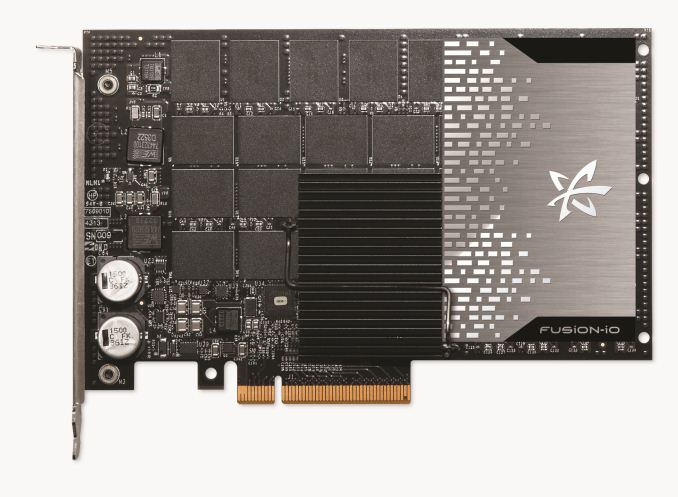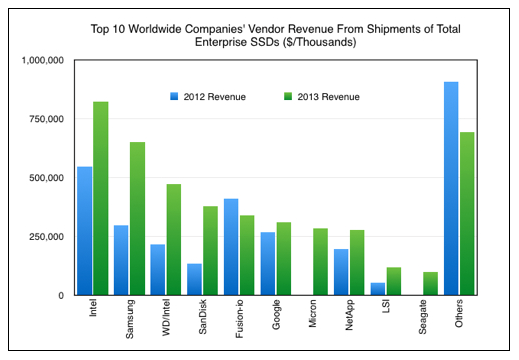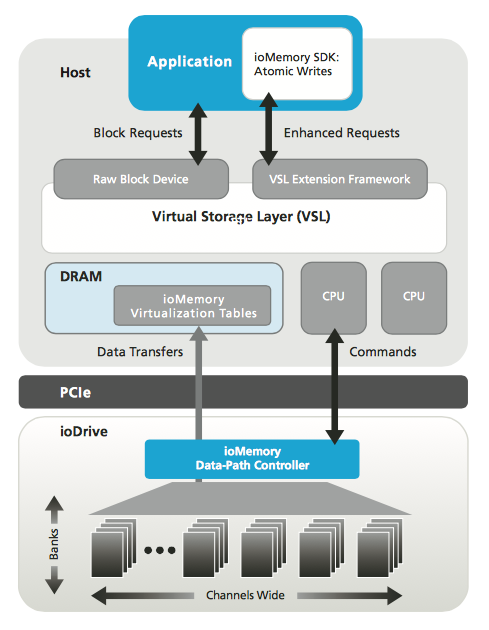The State of SanDisk
by Kristian Vättö on December 5, 2014 8:00 AM ESTThe Enterprise
In mid-July SanDisk announced their acquisition of Fusion-io and the acquisition was completed a couple of week prior to Flash Memory Summit. I posted my initial thoughts when the news hit the public, but I feel that it's worth doing a bit deeper analysis now that I have given it some more thought and discussed it with John Scaramuzzo, senior vice president and general manager of SanDisk's enterprise business.
SanDisk has managed to establish itself as one of the key players in the enterprise SSD space over the past few years. The acquisitions of Pliant in 2011 and SMART Storage Systems in 2013 provided SanDisk with strong expertise and product lineups for SATA and SAS SSDs but left the company without a solid long-term plan for PCIe. I heard Pliant's initial roadmap included plans for PCIe-based solutions as well, but it looks like those plans never materialized.
Up until the Fusion-io acquisition, the Lightning PCIe SSA was the only PCIe solution in SanDisk's enterprise product portfolio, and as a matter of fact that drive is internally a SAS-based design with a PCIe to SAS bridge onboard. In other words, SanDisk had practically zero real PCIe solutions for the enterprise, while at the same time SanDisk's biggest competitors, such as Intel and Samsung, have had PCIe drives for a long while already.
Fusion-io's 3.2TB Atomic Series SSD
Fusion-io's strategy and product portfolio, on the other hand, was a complete opposite. From the beginning Fusion-io has focused on PCIe storage, which dates all the way back to 2007 when the company released its first ioDrive that utilized a PCIe x4 interface and was capable of speeds up to 800MB/s. Not only was Fusion-io early in the market, but the company was also able to garner a few massive and very important clients – the most notable being Facebook and Apple. I don't think it's an overstatement to say that Fusion-io can be considered as the pioneer of PCIe storage because it was the first company to turn PCIe SSDs and storage in general into a large, successful business.
But stories eventually come to an end. The competitive advantages Fusion-io had were its PCIe technology and several high-level customers, but the advantages were lost when the NAND manufacturers stepped into the PCIe territory. It's nearly impossible for a company that has to source its NAND from a third party to compete against another company that manufactures NAND in-house since the latter will always have advantages in cost. While Fusion-io didn't lose its customers to competitors overnight, it's clear that especially Intel and Samsung snagged a share of Fusion-io's business in the past couple of years.
In a nutshell, the acquisition brings SanDisk the long-needed expertise in PCIe storage along with Fusion-io's broad PCIe product portfolio. The acquisition is now a bit over 100 days in and the Fusion-io employees have been integrated into SanDisk's existing teams. Initially Fusion-io's engineering team was separate and worked under Lance Smith, the former President and COO of Fusion-io, but Mr. Smith decided to leave SanDisk and pursue other options. Last week a data virtualization startup Primary Data announced that Mr. Smith has joined the company as the new CEO, which explains his quick departure from SanDisk.
All the engineering talent has now been unified and the team is lead by Mr. Scaramuzzo. With everyone under the same roof, the roadmaps are now in the process of being integrated to bring the expertise together. It will be a while before we see the fruits of the acquisition, but in the meantime the latest Fusion-io products will transition to SanDisk NAND for increased cost efficiency.
But what about NVMe? That has been the hot topic in the industry this year and I bet many of you are wondering what is SanDisk's and Fusion-io's play in that field. The short version of their strategy is that Fusion-io already has a technology called Virtual Storage Layers (VSL), which is essentially a driver/software stack similar to NVMe. The truth is that NVMe isn't really anything new from a technology perspective, but what makes it alluring for many manufacturers is the fact that the NVMe drivers are universal and already supported by the latest operating systems. Technologies like VSL are rather expensive to develop and require expertise because there is no framework available (i.e. everything has to be developed from scratch), but on the other hand an in-house driver like VSL allows for more customization and optimization.
However, that doesn't mean that SanDisk has no interest on NVMe whatsoever. The company sees that as the entry and mid-level enterprise SSDs move from SATA and SAS to PCIe, NVMe will be one of the key factors because of easy and quick deployment. For that market segment the NVMe spec and its limitations are fine – it's only the high-end segment where the benefits of VSL are more prominent. It's actually likely that many manufacturers will turn to custom NVMe drivers anyway for higher and more optimized performance, and in fact that is already happening with Intel providing its own NVMe driver for the P3600/P3700.
Lastly, let's quickly discuss the ULLtraDIMM. I wrote a quick piece on ULLtraDIMM right after Flash Memory Summit, but SanDisk has already scored Huawei as the third ULLtraDIMM partner (in addition to IBM and Supermicro). The first generation product that is currently available is internally based on a pair of SATA 6Gbps controllers, but SanDisk said that a native DDR to NAND controller is possible in the future if the market adopts the new form factor well. As usual, the industry is fairly slow in adopting new form factors, so it's hard to say whether NAND DIMMs will really take off, but it's a very interesting and potentially useful technology.
Final Words
All in all, SanDisk is definitely one of the most interesting NAND companies going forward. USB drives, eMMC solutions, SSDs and even the storage arrays from the Fusion-io acquisition are all built on NAND, which puts SanDisk in a unique position as it's the only NAND manufacturer that focuses solely on NAND products. The company can't turn to alternative revenue sources like e.g. Intel and Samsung can, but on the other hand that's also SanDisk's strength as all the know-how and experience in the company is related to NAND in one way or the other.
Ultimately next year will be crucial for SanDisk because it determines whether the company can materialize all the underlying potential from the Fusion-io acquisition and become a serious competitor to Intel and Samsung in the enterprise space. The pieces are definitely there, so it's just a matter of execution now.














132 Comments
View All Comments
Icehawk - Friday, December 5, 2014 - link
The big OEMS don't even offer SSDs on their desktops below ~$2k in my recent experience trying to help a friend out - or if they do it is at an insane markup (like 128gb for +$300).I have a friend, Unix admin for 15yrs, a super nerd... and he is still afraid of SSDs dying like the first ones he had 5 years ago.
Hard to convince non-techies that the key to unlocking performance is using an SSD since traditionally all they think about is the CPU. Did my mom buy an SSD equipped laptop after I explained the new one she was looking at would basically perform exactly like her old one? Nope.
NatePo717 - Friday, December 5, 2014 - link
2TB+ SATA SSDs at reasonable prices. Need solid state at high capacity.PPalmgren - Friday, December 5, 2014 - link
Just another thought, maybe the consumer OEMs like Dell are at odds with SSDs because of the massive increase in product longeivty they cause. The #1 thing making a computer feel 'slow' after a few years, especially cheapo laptops, is crappy hard drives burdened with too much cruft. The hard drive is also the part in a computer with the highest failure rate and the lowest life span. Maybe the SSD manufacturers and the OEMs are at an impasse, well, until one of them disrupts the market. I think when/if that happens, it will play similarly to the way T-Mobile destroyed cell phone contract prices.mickulty - Friday, December 5, 2014 - link
>What is it that we or manufacturers like SanDisk could do to boost the SSD penetration in the market?Cheaper SSDs. If an SSD could be used for the same cost as a basic hard drive, it would be much more attractive to OEMs. This might mean simpler, cheaper controllers as well as an effort to drop nand prices and the use of less nand dies - the performance would take a hit, but could still be more than a mechanical drive. Right now 64GB ssds are still around £5 more expensive than 320GB 2.5" hard drives at retail.
Also, personally I'd be tempted by decent cross-platform caching software.
zodiacfml - Friday, December 5, 2014 - link
Problem with the OEMs. They intentionally left SSD only as an option instead of a default because the computing device would perform well for years, making the upgrade cycle longer.To solve it, the consumers has to specifically look for devices with SSDs before OEMs scramble to place SSDs as the default on their products.
But, how do you educate the consumers now that they spend more time on a phone or tablet instead of an x86 machine? I saw Samsung a few years ago giving effort to educate consumers with the benefits of an SSD and yet the adoption rate still remains very slow.
Even the company I work for does not have an idea of SSDs. They still kept on buying new machines which are pretty much overkill for 99.9% of their use. An SSD will help will greatly with Windows updates which is a pain for everyone in the company and my job to deploy applications and maintenance.
Sushisamurai - Friday, December 5, 2014 - link
From my personal experience and my parents, I think SSD's have a few hurdles before they become mainstream. We're fairly tech savvy, but even for myself, I only put in an SSD on my new built system (2013; 128GB OS drive), but everything else is still on a HDD.Even at the time, not seeing any SSD's in action, I merely had an extra $300 to see what the hype was all about. Do I regret my purchase? No. Do I think it was necessary? Not at all.
1) I think the main issue is OEM market penetration. I've grown up with multiple systems all HDD based, even my 2011 laptop is HDD based. My family and I are so use to 1-3 minute boot times that a 10 second boot time is just an unnecessary luxury (but yes, launchin applications is faster) - we keep 3 of our desktops running 24/7, so boot times is essentially non-existent.
2) price. i wouldn't mind swapping my Ivy bridge laptop HDD for an SSD, but I've grown rather accustomed to my 750GB storage. Spending an additional $300-400 for a 512GB SSD seems unnecessary - I might as well save that money for a new laptop that comes with an SSD when this one dies.
3) Demos are needed. If consumers can't see real life examples of an SSD and HDD side by side doing the same thing. People won't be convinced. I certainly wasn't prior to buying one. It's almost like an ios vs android issue. Simplified interface of iOS won the masses initially compared to android, and now it's a price war.
Sushisamurai - Friday, December 5, 2014 - link
3.5) this is more of an after thought, but I think apple's going to have an edge for the next few years in terms of laptop sales. Most of their laptops are all on SSD's, increasing speed of responsiveness. Theyre on PCIe SSD's, a fact u don't see heavily marketed by Apple. The common person is going to use their laptops, and realize how snappy it is without knowing why, attributing the difference to apple/OS and not the SSD.They also don't offer an HDD to SSD upgrade option, instead the cost is "bundled". Smart marketing move, higher margin/priced laptops, with the consumer not really knowing the cost of parts (eg: adding $200-300 for an SSD in a laptop, would mean that SSD costs $200-300 - consumer would shop elsewhere for an SSD, probably not buy it due to the hassle or install/switch)
Klug4Pres - Friday, December 5, 2014 - link
Confession: I only own one SSD, which is a 120GB boot drive (a Sandisk!) in my HTPC. For that specific application, I could see that a snappy response was helpful and perhaps key to spousal adoption.For my main laptop, I use an old Thinkpad with a 4:3 screen (T60, SXGA+), and I know an SSD would help a lot, but I still won't spend the money. I'd like at least 240GB, and I'd stick a big hard drive in the second spindle. Maybe when I can pick one up for £50 in the UK. Cheapest I have seen so far, for periods of about 10 minutes on Amazon, is £65 for a Crucial, was it M500 or MX100, I don't recall.
Don't fancy TLC either, or tiny lithography. An end-of-line M500 is what I am hoping for.
Runamok81 - Friday, December 5, 2014 - link
Sandisk, please quit focusing on how to penetrate the broader consumer market. Focus on your core market, the enthusiasts. The 21% market share you have represents people that can do the data transfer and hardware upgrade themselves. And we're saturated. We've had SSDs commercially available for five years. And now that 128GB and 256GB are more palatable for the thriftier geeks, you can bet your mechanical keyboard we have an SSD in every device. Until you can scale operations -and SSD prices- into a true price-parity with HDDs, then OEMs will be unable to afford integrating these -relatively speaking- expensive SDDs into the lower levels of their product stack, and that untapped 79% will remain so. Why isn't SanDisk courting the margins of their captured market? SanDisk makes fantastic products. Among enthusiasts they have name recognition, reputation and brand loyalty. We will buy new SSDs, but we need a reason to replace our 3-year old SanDisk SSDs. If we can't have size, then we want SPEED! We like you, but where are your ultra-fast PCIe SSDs? We will upgrade for that. We might even pay a nice premium. Mom and Pop? Not so much. And these "market penetration" suggestions... a consumer education campaign? Good luck. A "geek squad" like HDD to SSD data transfer service? Ill-advised. What wet-behind-the-ears marketeer concluded that process wouldn't be a logistical and liability nightmare. As for Anandtech, slow news day? I enjoy market analysis, but acting as the mouthpiece for the SanDisk marketing department by trolling your visitors for "market penetration" ideas is a new low. Get back on track.
Kristian Vättö - Friday, December 5, 2014 - link
SanDisk sponsored my trip to FMS and in return we agreed to do an article about what SanDisk presented and showcased at the event. AnandTech doesn't cover international flights, so finding a sponsor was the only way I could attend the show. Note that this is the case with every trade show and is thus nothing new or out of the ordinary.However, SanDisk wasn't involved in the editorial process at all. The only condition they had is that the article needs to be linked to FMS and the meetings/presentations at the show, so I decided to write about TLC NAND and the Fusion-io acquisition as both are big things for SanDisk and the market in general, and one of SanDisk's presentation had interesting data about TLC as shown in the graphs in the article.
We also talked about SSD adoption for a lengthy period of time and I thought it makes sense to reach out to you, our readers, for input. SanDisk did not request or demand this -- it was all my idea. SSD is without a doubt the biggest upgrade that can be made to improve user experience and I'm genuinely interested in what can be done to increase the adoption rate. It's not for the marketing departments, but for all the people that could have better user experience if they knew about SSDs. I also think it's an excellent opportunity for you to be heard and there already great comments, which I'll definitely bring up when I meet with the companies at CES.
I hope this explains the situation. I'd like to emphasize that we are and will continue to be editorially independent and the purpose of sponsorships is to provide you with better content, for which attending trade shows and building relationships is crucial.